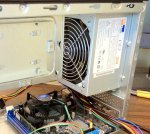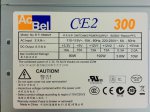professorpolymath
Dabbler
- Joined
- Aug 18, 2012
- Messages
- 14
There are quite a few threads discussing potential hardware choices for Mini-ITX builds. I thought some of you might like to see what combination of parts I settled on for my own home NAS project. Along with glamour shots. Component prices are Canadian $, before tax, from Aug 2012.
Case. Chenbro SR30169, 4-bay ($148.98) http://www.chenbro.com/corporatesite/products_detail.php?sku=195
Took some time to find a case for this project. I bought this based on reviews without having touched it, and am pleased to report it is very solid and looks good. The plastic front wouldn't suffer much abuse, but the rest of the case is heavy steel. The included power supply leaves something to be desired. I may replace it in the future with something more efficient. The plastic drive caddys are certainly not enterprise-grade, but they won’t but shuffled very often. I like that the drive bays are arrayed horizontally.
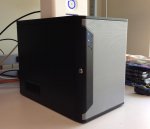
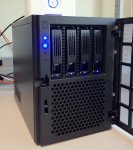
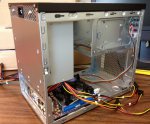
Mainboard. Intel DH77DF, Mini-ITX ($135.99) http://www.intel.com/content/www/us...p-motherboards/desktop-board-dh77df.html.html
This board has just about every kind of I/O currently in vogue. And a x16 PCI Express slot. And a nice BIOS. And, blessedly, no legacy ports (go to hell, parallel). My one wish is that it had two Ethernet ports.
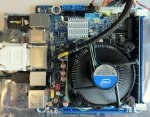
CPU. Intel Celeron G540 ($46.99) http://ark.intel.com/products/53416/Intel-Celeron-Processor-G540-2M-Cache-2_50-GHz
This dual-core 2.5GHz chip is low power and runs cool, and supports VT-x. I love that it was under $50. The mainboard supports quad-core i7 and Xeon chips if I need more speed (and heat and power consumption).
Memory. Kingston 8G DDR3-1333 ($42.99)
Starting out with 8 GB (plus another 2 GB stick I scavenged). Cheap and simple to double this down the road to the board’s 16 GB maximum.
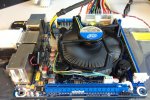
OS drive. OCZ Nocti 120GB mSATA ($89.99) http://www.ocztechnology.com/ocz-nocti-msata-ssd.html
This is a bit of a luxury; I’d intended to install the OS on a USB stick. But, this Nocti was on sale and my board has a slick little mSATA port. And look how adorable it is.
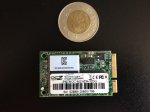
Storage. I'm reusing some 1 and 2 TB drives I have around for now. When drive prices come back down to earth, I will look at 3 or 4 TB disks.
Software. FreeNAS by itself is not very demanding, and the hardware in this little thing is quite capable, so I've decided to run VMware ESXi, with FreeNAS in a VM. Disks are passed through to FreeNAS using Virtual Device Mapping, so storage behaviour and performance is very close to bare-metal FreeNAS. And, crucially, disks can be exported to another ZFS-aware system. Goodbye HFS+, ext3, NTFS!
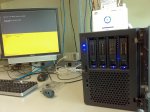
Case. Chenbro SR30169, 4-bay ($148.98) http://www.chenbro.com/corporatesite/products_detail.php?sku=195
Took some time to find a case for this project. I bought this based on reviews without having touched it, and am pleased to report it is very solid and looks good. The plastic front wouldn't suffer much abuse, but the rest of the case is heavy steel. The included power supply leaves something to be desired. I may replace it in the future with something more efficient. The plastic drive caddys are certainly not enterprise-grade, but they won’t but shuffled very often. I like that the drive bays are arrayed horizontally.



Mainboard. Intel DH77DF, Mini-ITX ($135.99) http://www.intel.com/content/www/us...p-motherboards/desktop-board-dh77df.html.html
This board has just about every kind of I/O currently in vogue. And a x16 PCI Express slot. And a nice BIOS. And, blessedly, no legacy ports (go to hell, parallel). My one wish is that it had two Ethernet ports.

CPU. Intel Celeron G540 ($46.99) http://ark.intel.com/products/53416/Intel-Celeron-Processor-G540-2M-Cache-2_50-GHz
This dual-core 2.5GHz chip is low power and runs cool, and supports VT-x. I love that it was under $50. The mainboard supports quad-core i7 and Xeon chips if I need more speed (and heat and power consumption).
Memory. Kingston 8G DDR3-1333 ($42.99)
Starting out with 8 GB (plus another 2 GB stick I scavenged). Cheap and simple to double this down the road to the board’s 16 GB maximum.

OS drive. OCZ Nocti 120GB mSATA ($89.99) http://www.ocztechnology.com/ocz-nocti-msata-ssd.html
This is a bit of a luxury; I’d intended to install the OS on a USB stick. But, this Nocti was on sale and my board has a slick little mSATA port. And look how adorable it is.

Storage. I'm reusing some 1 and 2 TB drives I have around for now. When drive prices come back down to earth, I will look at 3 or 4 TB disks.
Software. FreeNAS by itself is not very demanding, and the hardware in this little thing is quite capable, so I've decided to run VMware ESXi, with FreeNAS in a VM. Disks are passed through to FreeNAS using Virtual Device Mapping, so storage behaviour and performance is very close to bare-metal FreeNAS. And, crucially, disks can be exported to another ZFS-aware system. Goodbye HFS+, ext3, NTFS!


